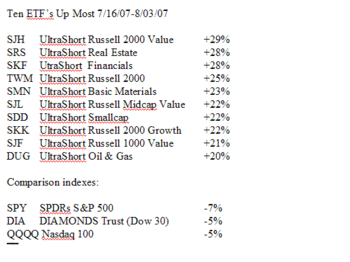The GMI moved up one to 2, as there were 107 new 52 week highs in my universe of 4,000 stocks. While the short term trend of the QQQQ (and the SPY and DIA) remains down, the quality of the current rally in the next few days will tell me whether the trend is reversing up. Cash is probably the right place for me to be right now.
 Dr. Wish
Dr. Wish
GMI:1; 10x more new lows than highs
The GMI is still one and the GMI-S is zero. There were 557 new lows and 52 new highs on Monday in my universe of 4,000 stocks. While 78-97% of the stocks in the major indexes advanced, only 60% of my universe of stocks rose, along with just 56% of the stocks in the twelve IBD100 stock lists I have been following for the past year. So the advance Monday occurred mainly in the stocks typified by the major index ETFs (SPY, DIA and QQQQ). The Worden T2108 indicator is 18%, up from Friday’s extreme low of 14%. Monday was the sixth day in the current QQQQ down-trend. I continue to be short or in cash until the GMI should signal an up-trend.
See my disclaimers below.
GMI: 1; UltraShort ETFs shine
Last week I received an email from my brokerage company saying that they noticed my account was in cash and, would I like their help in investing my money. I have been safely in money market funds collecting interest, and they want to lure me back into this declining market. The little guy doesn’t have a chance against the army of pros who think timing the market is impossible. The Fox business shows on Sunday were also filled with pundits saying that we should scoop up the many bargains in this market. So, with the GMI at 1 and the majority of pundits looking for bargains, this is not the time for me to be long stocks….
I ran a scan using TC2007 to see which ETF’s did well since the S&P500 peaked on July 16. Since that day, the S&P500 has declined 7.5%. Was I surprised that in that same period a lot of Proshares UltraShort ETF’s climbed more than 20%. These new inverse ETF’s go up when their relevant index declines. The UltraShort ETF’s are designed to rise 2x as much as the relevant index falls. So, look at the top 10 ETF’s (out of 551) since July 16:
It should be clear that during the time when the general market indexes were falling 5-7%, these UltraShort indexes rose 20% or more. The weakness in real estate, basic materials and financials is to be expected.  But note that the market really stuck it to the "value" stocks. This term is an oxymoron; value is a myth and only in the eyes of the beholder. We should not get stuck holding onto declining value stocks, which may become even more valuable as they fall and fall and fall. Bill O’Neil has said, all stocks are bad unless they are going up. So, if I do not have a margin account in which to short stocks or do not want to buy put options in my IRA, I can buy the UltraShort ETF’s and hopefully profit as other long term buy and hold investors wring their hands and curse the declining market. Thus far, my IRA account has come through this decline unscathed, retaining all profits from the past year.
But note that the market really stuck it to the "value" stocks. This term is an oxymoron; value is a myth and only in the eyes of the beholder. We should not get stuck holding onto declining value stocks, which may become even more valuable as they fall and fall and fall. Bill O’Neil has said, all stocks are bad unless they are going up. So, if I do not have a margin account in which to short stocks or do not want to buy put options in my IRA, I can buy the UltraShort ETF’s and hopefully profit as other long term buy and hold investors wring their hands and curse the declining market. Thus far, my IRA account has come through this decline unscathed, retaining all profits from the past year.
When will this decline end? Nobody knows. But there will be plenty of time to go long after the turn is reflected in the GMI….
See my disclaimers below.